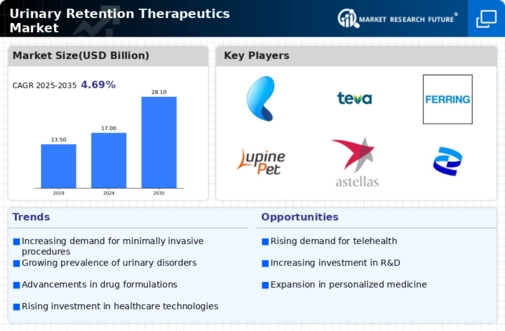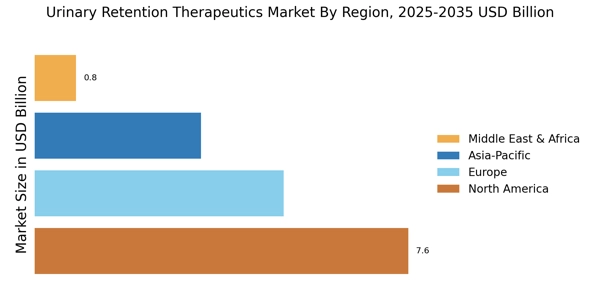Advancements in Medical Technology
Technological innovations play a pivotal role in shaping the Urinary Retention Therapeutics Market. Recent advancements in minimally invasive surgical techniques and drug delivery systems have enhanced treatment efficacy and patient outcomes. For instance, the development of new pharmacological agents and devices designed to alleviate urinary retention symptoms has gained traction. Market data indicates that the introduction of these technologies has led to a notable increase in treatment options available to patients, thereby expanding the market. As healthcare systems continue to adopt these advancements, the Urinary Retention Therapeutics Market is likely to witness sustained growth, driven by improved patient care and satisfaction.
Growing Focus on Patient-Centric Care
The Urinary Retention Therapeutics Market is increasingly influenced by the shift towards patient-centric care models. Healthcare providers are prioritizing individualized treatment plans that consider patient preferences and quality of life. This trend is evident in the development of therapies that not only address the physiological aspects of urinary retention but also enhance overall patient well-being. Market Research Future suggests that patient engagement and education initiatives are becoming integral to treatment protocols, fostering better adherence and outcomes. As the emphasis on patient-centered approaches continues to rise, the Urinary Retention Therapeutics Market is expected to evolve, aligning therapeutic strategies with patient needs.
Rising Awareness of Urological Health
The Urinary Retention Therapeutics Market is witnessing growth driven by increasing awareness of urological health issues among the general population. Educational campaigns and initiatives aimed at destigmatizing urinary conditions have led to more individuals seeking medical advice and treatment. This heightened awareness is particularly relevant in demographics that may have previously overlooked symptoms of urinary retention. Market analysis indicates that as awareness grows, so does the demand for effective therapeutic solutions. Consequently, the Urinary Retention Therapeutics Market is positioned to expand, as healthcare providers respond to the increasing number of patients seeking assistance for urinary retention.
Rising Incidence of Urinary Retention
The Urinary Retention Therapeutics Market is experiencing growth due to the increasing prevalence of urinary retention conditions. Factors such as aging populations and the rise in chronic diseases contribute to this trend. According to health statistics, urinary retention affects a significant portion of the elderly, with estimates suggesting that nearly 30% of older adults may experience some form of urinary retention. This demographic shift necessitates effective therapeutic solutions, thereby driving demand within the market. As healthcare providers seek to address these challenges, the Urinary Retention Therapeutics Market is poised for expansion, with a focus on innovative treatment options that cater to this growing patient population.
Increased Research and Development Investments
Investment in research and development is a critical driver for the Urinary Retention Therapeutics Market. Pharmaceutical companies and research institutions are allocating substantial resources to explore novel therapeutic options and improve existing treatments. This focus on R&D is essential for addressing the unmet needs of patients suffering from urinary retention. Recent data indicates that the global expenditure on healthcare R&D has been on the rise, with a significant portion directed towards urology-related therapies. As these investments yield new insights and innovations, the Urinary Retention Therapeutics Market is likely to benefit from a broader array of effective treatment modalities.


















Leave a Comment